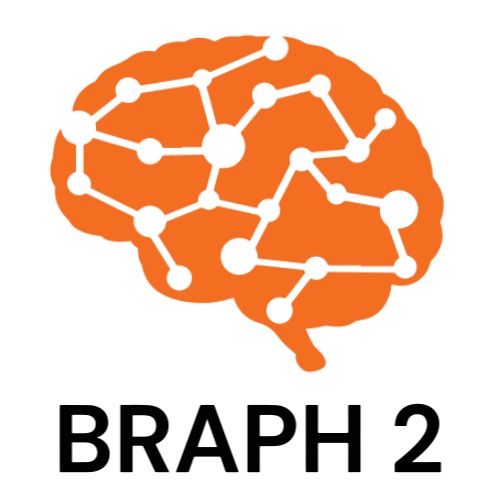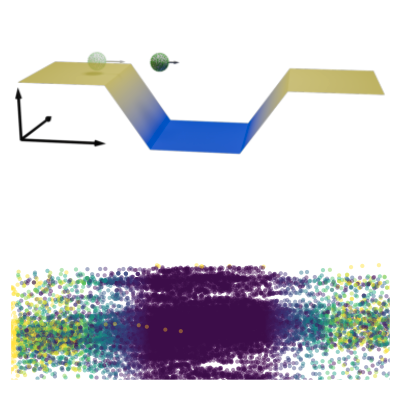Theme C: Machine learning and Data-driven focus
Giovanni Volpe
Program for Academic Leaders in Life Science (PALS) Conference 2025
Date: 3 June 2025
Time: 13:45
Place: Gothenburg, Sweden
Tag: Giovanni Volpe
Invited Seminar by G. Volpe at Cognitive and Behavior Changes in Parkinson’s Disease and Parkinsonism: Advances and Challenges, Santa Maria di Leuca, Italy, 21 May 2025

Giovanni Volpe
Cognitive and Behavior Changes in Parkinson’s Disease and Parkinsonism: Advances and Challenges
Date: 21 May 2025
Time: 11:50
Place: Tricase, Santa Maria di Leuca, Italy
Delayed Active Swimmer in a Velocity Landscape on ArXiv

Viktor Holubec, Alexander Fischer, Giovanni Volpe, Frank Cichos
arXiv: 2505.11042
Self-propelled active particles exhibit delayed responses to environmental changes, modulating their propulsion speed through intrinsic sensing and feedback mechanisms. This adaptive behavior fundamentally determines their dynamics and self-organization in active matter systems, with implications for biological microswimmers and engineered microrobots. Here, we investigate active Brownian particles whose propulsion speed is governed by spatially varying activity landscapes, incorporating a temporal delay between environmental sensing and speed adaptation. Through analytical solutions derived for both short-time and long-time delay regimes, we demonstrate that steady-state density and polarization profiles exhibit maxima at characteristic delays. Significantly, we observe that the polarization profile undergoes sign reversal when the swimming distance during the delay time exceeds the characteristic diffusion length, providing a novel mechanism for controlling particle transport without external fields. Our theoretical predictions, validated through experimental observations and numerical simulations, establish time delay as a crucial control parameter for particle transport and organization in active matter systems. These findings provide insights into how biological microorganisms might use response delays to gain navigation advantages and suggest design principles for synthetic microswimmers with programmable responses to heterogeneous environments.
SmartTrap: Automated Precision Experiments with Optical Tweezers on ArXiv

Martin Selin, Antonio Ciarlo, Giuseppe Pesce, Lars Bengtsson, Joan Camunas-Soler, Vinoth Sundar Rajan, Fredrik Westerlund, L. Marcus Wilhelmsson, Isabel Pastor, Felix Ritort, Steven B. Smith, Carlos Bustamante, Giovanni Volpe
arXiv: 2505.05290
There is a trend in research towards more automation using smart systems powered by artificial intelligence. While experiments are often challenging to automate, they can greatly benefit from automation by reducing labor and increasing reproducibility. For example, optical tweezers are widely employed in single-molecule biophysics, cell biomechanics, and soft matter physics, but they still require a human operator, resulting in low throughput and limited repeatability. Here, we present a smart optical tweezers platform, which we name SmartTrap, capable of performing complex experiments completely autonomously. SmartTrap integrates real-time 3D particle tracking using
deep learning, custom electronics for precise feedback control, and a microfluidic setup for particle handling. We demonstrate the ability of SmartTrap to operate continuously, acquiring high-precision data over extended periods of time, through a series of experiments. By bridging the gap between manual experimentation and autonomous operation, SmartTrap establishes a robust and open source framework for the next generation of optical tweezers research, capable of performing large-scale studies in single-molecule biophysics, cell mechanics, and colloidal science with reduced experimental
overhead and operator bias.
Invited Talk by G. Volpe at OPIC/OMC 2025, Yokohama, Japan, 21 April 2025 (Online, Pre-recorded)

Giovanni Volpe
Optics & Photonics International Congress 2025 (OPIC 2025), The 11th Optical Manipulation and Structured Materials Conference (OMC2025)
Date: 21 April 2025
Time: 13:45 JST
Place: Yokohama, Japan (Online, Pre-recorded)
BRAPH 2: a flexible, open-source, reproducible, community-oriented, easy-to-use framework for network analyses in neurosciences on bioRxiv

Yu-Wei Chang, Blanca Zufiria-Gerbolés, Pablo Emiliano Gómez-Ruiz, Anna Canal-Garcia, Hang Zhao, Mite Mijalkov, Joana Braga Pereira, Giovanni Volpe
bioRxiv: 10.1101/2025.04.11.648455
As network analyses in neuroscience continue to grow in both complexity and size, flexible methods are urgently needed to provide unbiased, reproducible insights into brain function. BRAPH 2 is a versatile, open-source framework that meets this challenge by offering streamlined workflows for advanced statistical models and deep learning in a community-oriented environment. Through its Genesis compiler, users can build specialized distributions with custom pipelines, ensuring flexibility and scalability across diverse research domains. These powerful capabilities will ensure reproducibility and accelerate discoveries in neuroscience.
Computational memory capacity predicts aging and cognitive decline published in Nature Communications

Mite Mijalkov, Ludvig Storm, Blanca Zufiria-Gerbolés, Dániel Veréb, Zhilei Xu, Anna Canal-Garcia, Jiawei Sun, Yu-Wei Chang, Hang Zhao, Emiliano Gómez-Ruiz, Massimiliano Passaretti, Sara Garcia-Ptacek, Miia Kivipelto, Per Svenningsson, Henrik Zetterberg, Heidi Jacobs, Kathy Lüdge, Daniel Brunner, Bernhard Mehlig, Giovanni Volpe, Joana B. Pereira
Nature Communications 16, 2748 (2025)
doi: 10.1038/s41467-025-57995-0
Memory is a crucial cognitive function that deteriorates with age. However, this ability is normally assessed using cognitive tests instead of the architecture of brain networks. Here, we use reservoir computing, a recurrent neural network computing paradigm, to assess the linear memory capacities of neural-network reservoirs extracted from brain anatomical connectivity data in a lifespan cohort of 636 individuals. The computational memory capacity emerges as a robust marker of aging, being associated with resting-state functional activity, white matter integrity, locus coeruleus signal intensity, and cognitive performance. We replicate our findings in an independent cohort of 154 young and 72 old individuals. By linking the computational memory capacity of the brain network with cognition, brain function and integrity, our findings open new pathways to employ reservoir computing to investigate aging and age-related disorders.
Global graph features unveiled by unsupervised geometric deep learning on ArXiv

Mirja Granfors, Jesús Pineda, Blanca Zufiria Gerbolés, Joana B. Pereira, Carlo Manzo, Giovanni Volpe
arXiv: 2503.05560
Graphs provide a powerful framework for modeling complex systems, but their structural variability makes analysis and classification challenging. To address this, we introduce GAUDI (Graph Autoencoder Uncovering Descriptive Information), a novel unsupervised geometric deep learning framework that captures both local details and global structure. GAUDI employs an innovative hourglass architecture with hierarchical pooling and upsampling layers, linked through skip connections to preserve essential connectivity information throughout the encoding-decoding process. By mapping different realizations of a system – generated from the same underlying parameters – into a continuous, structured latent space, GAUDI disentangles invariant process-level features from stochastic noise. We demonstrate its power across multiple applications, including modeling small-world networks, characterizing protein assemblies from super-resolution microscopy, analyzing collective motion in the Vicsek model, and capturing age-related changes in brain connectivity. This approach not only improves the analysis of complex graphs but also provides new insights into emergent phenomena across diverse scientific domains.
Optical Label-Free Microscopy Characterization of Dielectric Nanoparticles published in Nanoscale

Berenice Garcia Rodriguez, Erik Olsén, Fredrik Skärberg, Giovanni Volpe, Fredrik Höök, Daniel Sundås Midtvedt
Nanoscale, 17, 8336-8362 (2025)
arXiv: 2409.11810
doi: 10.1039/D4NR03860F
In order to relate nanoparticle properties to function, fast and detailed particle characterization, is needed. The ability to characterize nanoparticle samples using optical microscopy techniques has drastically improved over the past few decades; consequently, there are now numerous microscopy methods available for detailed characterization of particles with nanometric size. However, there is currently no “one size fits all” solution to the problem of nanoparticle characterization. Instead, since the available techniques have different detection limits and deliver related but different quantitative information, the measurement and analysis approaches need to be selected and adapted for the sample at hand. In this tutorial, we review the optical theory of single particle scattering and how it relates to the differences and similarities in the quantitative particle information obtained from commonly used microscopy techniques, with an emphasis on nanometric (submicron) sized dielectric particles. Particular emphasis is placed on how the optical signal relates to mass, size, structure, and material properties of the detected particles and to its combination with diffusivity-based particle sizing. We also discuss emerging opportunities in the wake of new technology development, with the ambition to guide the choice of measurement strategy based on various challenges related to different types of nanoparticle samples and associated analytical demands.
Retina electronic paper with video-rate-tunable 45000 pixels per inch on ArXiv

Ade Satria Saloka Santosa, Yu-Wei Chang, Andreas B. Dahlin, Lars Osterlund, Giovanni Volpe, Kunli Xiong
arXiv: 2502.03580
As demand for immersive experiences grows, displays are moving closer to the eye with smaller sizes and higher resolutions. However, shrinking pixel emitters reduce intensity, making them harder to perceive. Electronic Papers utilize ambient light for visibility, maintaining optical contrast regardless of pixel size, but cannot achieve high resolution. We show electrically tunable meta-pixels down to ~560 nm in size (>45,000 PPI) consisting of WO3 nanodiscs, allowing one-to-one pixel-photodetector mapping on the retina when the display size matches the pupil diameter, which we call Retina Electronic Paper. Our technology also supports video display (25 Hz), high reflectance (~80%), and optical contrast (~50%), which will help create the ultimate virtual reality display.




